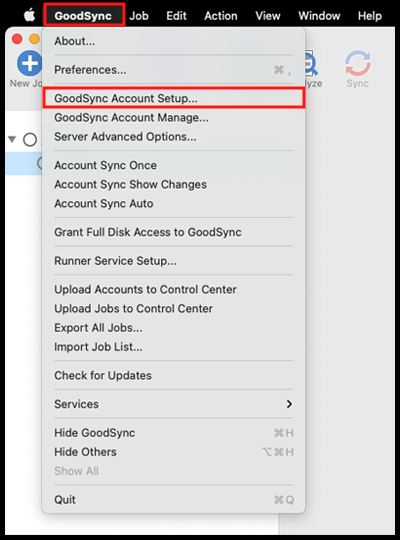
- #Goodsync for mac open without icon how to#
- #Goodsync for mac open without icon mp4#
- #Goodsync for mac open without icon generator#
- #Goodsync for mac open without icon Offline#
#Goodsync for mac open without icon Offline#
Sync lets you edit files using offline programs, then sends the changed files to the cloud.
#Goodsync for mac open without icon how to#
If you’re a OneDrive user, read our how to map OneDrive as a network drive article to learn how to set that up. The reason for that is your cloud storage content will sync, or download, to your computer. It won’t save you disk space but will let you access your content faster. That said, using cloud storage as a local drive is different than using it as a cloud network drive. Plus, if your hard drive malfunctions or someone steals your laptop, your important files won’t be lost. Also, our definition of “treat” may differ from yours.Ĭloud storage lets you collaborate with others by keeping your files in the cloud. That said, if you use offline apps that require you to access cloud storage files, you’re in for a treat because we’re going to tell you how to access cloud storage like a local drive in this article. Given that the internet is likely the reason you’re using a computer, it’s reasonable to assume you won’t hesitate to use it to access your cloud storage.
#Goodsync for mac open without icon mp4#
MP4 Repair: How to Fix Corrupted Video Files in 2019.Best Choice Stellar Phoenix Data Recovery.
#Goodsync for mac open without icon generator#
How to Create a Strong Password in 2023: Secure Password Generator & 6 Tips for Strong Passwords.How to Securely Store Passwords in 2023: Best Secure Password Storage.Best Password Manager for Small Business.How to Access the Deep Web and the Dark Net.Online Storage or Online Backup: What's The Difference?.Time Machine vs Arq vs Duplicati vs Cloudberry Backup.GoodSync has a 30-days free trial, to proceed with paid usage follow this link. Check Active Mode box only if Passive mode connection is not allowed by the server and if your firewalls allow servers to initiate FTP data connection to the client.įor more information on how to use GoodSync, you can use Manual guidelines on the GoodSync website. Active Mode or Passive Modeīy default, GoodSync uses Passive FTP mode when connecting because in this mode no data connections from server to client are required and these connections are not allowed by most firewalls. In Implicit mode, the connection to the server is open in SSL mode right away (on port 990) without any negotiation. In Explicit mode, GoodSync negotiates with the server about what encryption to use. Explicit is the default and recommended mode. Check Secure Mode box under the Browse button and URL prefix will change from ftp: to ftps: which means that GoodSync will try to establish encrypted FTPS connection to the FTP server.įTPS has two modes: Explicit and Implicit. However, if your FTP server supports FTPS (FTP over SSL) then you can encrypt your FTP transfer.

Secure mode (FTPS): Explicit and Implicitīy default, your UserID, Password, and data are not encrypted when transferred between your client and FTP server. If the folder you want to sync with does not exist, create it: navigate to its parent folder and click Make New Folder button. Navigate to the folder to sync within the folder tree.ħ. If the connection is successful, the Home Folder of UserID you used is shown and all folders above it.


Then click the Save button to connect to the server and test whether the data you entered is correct.Ħ. Then enter UserID, Password and maybe other connection data (Remote FS only), for example, fast-banana, password, and port: 22.ĥ.

Then enter or edit your Remote Server Address in Address field (Remote FS only), for example, .Ĥ. To change File System Type, click on different file systems on the left.ģ. File System Type appears in the left navigation pane of the Browse dialog. Click the Browse button or folder icon on the left or right side of Sync. GoodSync synchronizes with Remote File Systems (FS) accessible through these protocols: FTP and Secure FTP (SSH).ġ.


 0 kommentar(er)
0 kommentar(er)
